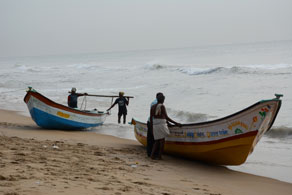


February 2018
Mainstreaming EAFM in the Philippines: available on BFAR website. A program of BFAR to implement EAFM as provided under the amended Fisheries Code. Adapted materials and resources developed specifically for the Philippines context are now freely available on the website of Philippines Bureau of Fisheries and Aquatic Resources (BFAR).
December 2017
New E-EAFM course online in English and Spanish! See home page for details and link.
November-December 2017
EEAFM course and associated Training of Trainers in Costa Rica, supporting 6 countries from the REBYC II-LAC project: Brazil, Costa Rica, Colombia, Mexico, Suriname and Trinidad and Tobago. 27 participants from the 6 project countries and FAO HQ and regional offices assembeld in Heredia for the 5-day EEAFM course. 17 stayed on for the ensuing ToT in Tarcoles. Both workshops were run simultaneously in English and Spanish. Great sharing between government officials and researchers, academics and representatives of fisher associations - both small scale and commercial.
The 6 participating Latin America and Caribbean country teams presented solid strategies for supporting the development/revision of pilot site fisheries management plans. Additional coaching was provided by REBYC II-LAC project coordinator and a senior lecturer from the University of West Indies.
May 2017
1st EEAFM course in Latin America region taking place in Spanish in Mexico City.
The course is organised by The Nature Conservancy, and Mexican government fisheries agencies CONAPESCA and INAPESCA, and is part of a wider three-year capacity building programme primarily focussed, in the first instance, on these two government agencies. The course is being run in Spanish, with most of the materials having been translated into Spanish.
March 2017
Recent mainstreaming EAFM planning workshop, Philippines
It is exciting to see the increasing shift in the Philippines from EAFM training to implementation of the EAFM Planning Process. This 4-day workshop held in Calbayog, Visayas Province, was supported by USAID, NOAA, ECOFISH, and the Philippines Bureau of Fisheries and Aquatic Resources. Approximately 50 local governmental unit officials from 16 municipalities from the region worked together develop an EAFM plan for the fisheries management unit in the San Bernardino Strait and Ticao Pass - moving from theory to practice with an ecosystem approach to fisheries management and sustainable development. Read more here
September 2016
The National Oceanic and Atmospheric Administration (NOAA) and University of Hawaii Filipino PhD student Rollan Geronimo, supported by the U.S. Agency for International Development, are providing night light fishing, climate and other fisheries information and tools to the Philippines Bureau of Fisheries and Aquatic Resources (BFAR) to provide managers with current and projected scientific input toward their EAFM and climate change adaptation plans. They are generating spatial data for fisheries, analyzing environmental effects on the fisheries, and projecting impacts of climate change on coastal pelagic fish which are an important source of both protein supply and livelihoods for many Filipino families. During Sept 26 - 30, 2016, NOAA oceanographer Roberto Venegas and Geronimo led a feedback Workshop on Climate Change and Fisheries products for EAFM and shared this information further during BFAR’s 7th Fisheries Science Conference.
December 2015 Thailand develops EAFM Plan
Thailand developed its first Ecosystem Approach to Fisheries Management Plan, based on EAF concepts. EAFM Consortium SEAFDEC will be monitoring the FMP’s implementation.
July 2016 The Philippines has formally institutionalized EAFM
The EAFM consortium has been contributing to the mainstreaming of EAF in fishery management over the recent years. The good news is that we can now see impact: the Philippines has formally institutionalized EAFM as a planning vehicle for its fishery management. It is also being undertaken with explicit links to integrated coastal management planning, bridging the divide that often emerges between fishery management and broader-scale coastal planning.